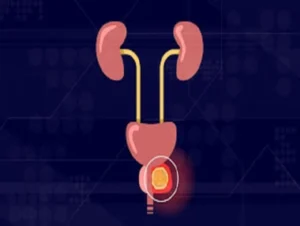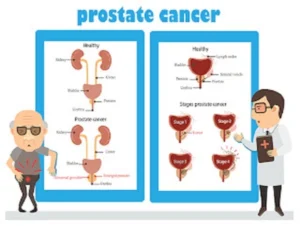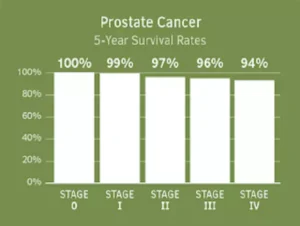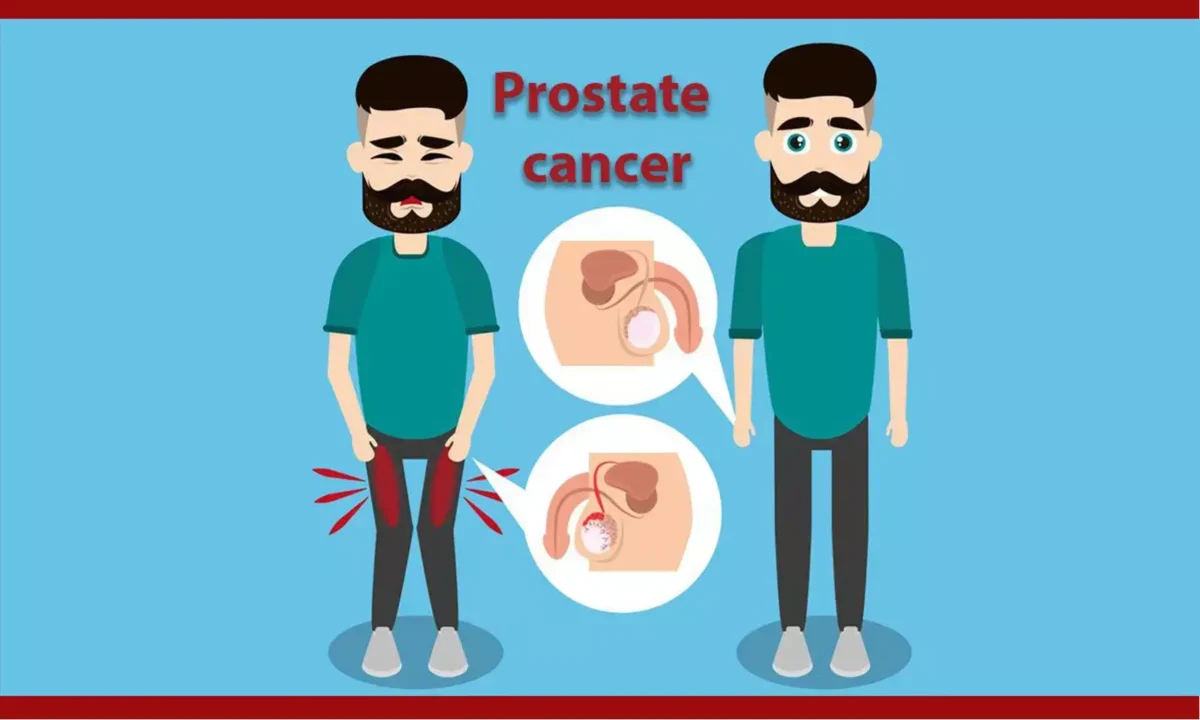Cancer-related deaths among men are primarily caused by prostate cancer. It develops in the prostate, the size of a walnut gland in the male reproductive system. Slow-growing prostate tumor can be life-threatening if it is not detected and treated early.

We will discuss here:
- Causes of Prostate Cancer
- Symptoms of prostate cancer
- Stages of prostate tumor
- diagnosis of Prostate cancer
- Treatment of Prostate Cancer
- The prostate cancer survival rate
- How we can prevent from this
Causes of Prostate Cancer:
It’s a complex disease with numerous potential causes. Several risk factors have been identified that increase the likelihood of prostate tumors developing. Some of these risk factors include age, family history, ethnicity, and lifestyle.
Age: It’s most common in men over the age of 65, although it can affect younger men as well. Studies have shown that a man’s risk of prostate neoplasm doubles every ten years after the age of 50.
Family History: Having a close relative with it, such as a father or brother, increases the risk of developing it.
Ethnicity: It is more likely to occur in African-American men than in men of other racial or ethnic groups.
Lifestyle: People who lead an unhealthy lifestyle may be more likely to develop it. This includes those who are overweight, smoke or don’t get enough exercise. Also, diets that are high in fat and low in fruits and vegetables have been linked to increased risk.
These risk factors do not necessarily mean that a man will develop them, but it is important to be aware of them as a means of reducing their risk through healthy lifestyle choices.
Symptoms:
Symptoms of prostate tumors can vary from person to person and may depend on the stage and progression of the disease. Typical symptoms of prostate cancer include an
- Increase in urinary frequency
- general fatigue or weakness.
- Pain or burning with urination
- The inability to start or stop a urine stream
- Blood in the urine or semen
- Erectile dysfunction
- Pain during ejaculation
- Pain in the lower back
- Other less common symptoms include swelling of the feet or ankles, urinary incontinence, and enlarged lymph nodes.
It is important to note that many of these symptoms can occur with other conditions and do not necessarily indicate prostate neoplasm. it is important to get evaluated by a medical professional if you are experiencing any of these symptoms.
prostate tumors can be symptomless in their early stages. But as cancer progresses, it can cause changes in urinary habits, such as difficulty urinating or an increased frequency or urgency. It can also cause pain or difficulty while urinating, blood in the urine or semen, and erectile dysfunction.
Stages of Prostate Tumor:
Prostate tumors can affect people of any age and it’s important to recognize the signs and symptoms early on otherwise it will be life-threatening.
In the early stages, it is very difficult to detect because there may be very few or no symptoms at all. However, some symptoms an individual may experience include difficulty urinating, frequent urination, a weak or interrupted urinary stream, and pain or burning during urination. Once cancer has spread beyond the prostate, individuals may also begin to experience back pain, hip pain, pain or weakness in their legs, and/or problems with bowel movements. It’s important to note that in the later stages of this disease, individuals may also experience difficulty breathing, blood in the urine, unexplained weight loss, swelling in the legs, or difficulty swallowing.
It’s highly recommended to consult with a doctor if any of these symptoms are present. Early detection and treatment can significantly increase the chances of successful recovery and survival.
Diagnosis of Prostate Cancer
This cancer can be diagnosed through a variety of tests including
- A digital rectal exam,
- A prostate-specific antigen (PSA) test
- Biopsies, and
- Imaging scans

Your doctor will determine which test is best based on your medical history and physical exam. If they suspect cancer, they may recommend a biopsy of the prostate to confirm the diagnosis.
Treatment of prostate cancer:
The treatment options will depend on the stage and location of the cancer, as well as its severity. It is important to meet with an oncology team to determine the best course of action. If the tumor is small and localized, cancer may be treated with surgery, radiation therapy, or cryotherapy.
- Surgery may include radical prostatectomy or if the tumor has spread, a minimally invasive laparoscopic prostatectomy.
- Radiation therapy can also destroy cancer cells and may be beneficial in some cases.
- Cryotherapy may be used in some cases where the tumor is localized, but this is typically done in combination with other treatments.
- Hormone therapy may also be used in combination with other treatments, to reduce the amount of testosterone in the body and slow the growth of the cancer cells.
- In advanced cases, chemotherapy may be used to treat cancer. As with all medical treatments, there are potential side effects to consider.
Discussing these possibilities with your oncology team before deciding on a treatment plan is important.
prostate – 33 Herbs Saw Palmetto Prostate Health Supplement for Men | Non GMO Prostate Support Bladder Control Pills to Reduce Frequent Urination & DHT Blocker to Prevent Hair Loss, 90 Capsules
Prostate Cancer survival rate:
It’s important to recognize potential symptoms at the early stages to ensure a better prognosis and successful recovery.
For localized prostate cancer, the five-year relative survival rate is 100%. This means that all people diagnosed with localized prostate tumors in a given year were still alive five years later. However, for regional prostate tumors, the five-year relative survival rate drops to 98.3%. When it comes to distant prostate cancer, the five-year relative survival rate drops to 29.7%. This means that only about three out of ten people diagnosed with distant prostate malignancy were still alive five years later.

Overall, if the prostate neoplasm is identified and treated early, the chances of successful recovery and survival are much higher. It’s important to stay vigilant and to consult with a doctor if any suspicious symptoms arise
Preventions:
1) Exercise Regularly: Regular exercise has been shown to reduce the risk of this cancer, while also improving overall health. Consistent aerobic activity helps reduce inflammation, which can lead to an enlarged prostate. Additionally, regular exercise can help alleviate the symptoms of an enlarged prostate.
2) The risks of prostate tumors, as well as contributing to overall health. Choose foods that are high in antioxidants and minerals, such as fruits and vegetables, and limit your intake of red and processed meats. Also, make sure to include plenty of omega-3 fatty acids, which have been linked to a reduced risk of cancer.
3) Get Regular Checkups: Make sure to get regular checkups with your doctor so they can monitor your prostate health. Your doctor may recommend a prostate exam, along with screening for prostate-specific antigen (PSA). This is a protein produced by the prostate, which can be an early indicator of prostate cancer.
4) Limit Alcohol Intake: Drinking alcohol in large amounts has been linked to an increased risk of prostate tumors. It is best to limit your alcohol consumption to two drinks a day or less.
5) Quit Smoking: Another way to reduce the risk of cancer is to quit smoking. The chemicals in cigarette smoke can increase inflammation, which can lead to an enlarged prostate. Additionally, smoking increases the risk of other forms of cancer as well. If you’re trying to quit smoking, talk to your doctor about resources that can help.
Commonly Asked FAQs:
What is prostate cancer?
Answer: prostate malignancy is a type of cancer that develops in a man’s prostate gland. The prostate is a small, walnut-shaped gland located between the bladder and the penis.
What are the 5 warning signs of a prostate tumor?
Answer:
1. Frequent urination, especially at night
2. Difficulty starting or stopping the stream of urine
3. Pain or burning sensation during urination
4. Blood in the urine or semen
5. Pain in the lower back, hips, or upper thighs
What is the best way to test for prostate tumors?
Answer: The best way to test for prostate cancer is through a prostate-specific antigen (PSA) test. This test measures the amount of PSA in a man’s blood. The higher the level, the more likely it is that the prostate tumor is present. In some cases, doctors may also perform a digital rectal exam to examine the prostate directly.
What are the best treatment options for prostate cancer?
Answer: The best treatment option for prostate cancer will depend on a variety of factors, including the stage of cancer, the patient’s age and health, and the patient’s preferences. Treatment options may include surgery, radiation therapy, hormone therapy, and/or chemotherapy. Your doctor can help you determine the best treatment option for your specific situation.
What are the main symptoms of prostate cancer?
Answer: Symptoms of this cancer can include frequent urination, weak or interrupted urine flow, pain or burning during urination, and blood in the urine or semen.
What are the risk factors for prostatic carcinoma?
Answer: Risk factors for this cancer include age, family history, race, and diet.
What tests are used to diagnose prostate cancer?
Answer: Tests used to diagnose prostatic carcinoma include a digital rectal exam, a prostate-specific antigen (PSA) test, and a biopsy.
How is prostate cancer treated?
Answer: Treatment for prostate cancer depends on the stage of cancer and the patient’s overall health. Treatment options may include surgery, radiation therapy, hormonal therapy, chemotherapy, or cryotherapy.
Is there a cure for prostate cancer?
Answer: Prostate cancer can be cured if it is caught in the early stages.
Is prostate cancer preventable?
Answer: There is no sure way to prevent prostate cancer, but there are steps you can take to reduce your risk, such as eating a healthy diet and exercising regularly.
What are the side effects of prostate cancer treatment?
Answer: Side effects of prostate cancer treatment can include urinary incontinence, erectile dysfunction, fatigue, and hot flashes.
What is the prognosis for prostate cancer?
Answer: The prognosis for prostate cancer depends on a variety of factors, including the stage of cancer, the patient’s age, and overall health, and the type of treatment chosen.
Are there any clinical trials available for prostate cancer?
Answer: Yes, there are several clinical trials for prostate cancer that are ongoing.
What is the difference between localized and advanced prostate cancer?
Answer: Localized prostate cancer is confined to the prostate gland and has not spread to other parts of the body. Advanced prostate cancer has spread beyond the prostate gland.
Can prostate cancer spread to other parts of the body?
Answer: Yes, prostate cancer can spread to other parts of the body, such as the bones and lymph nodes.
What diet changes should I make if I have prostate cancer?
Answer: If you have prostate cancer, it is important to eat a healthy diet that is low in fat and high in fruits and vegetables.
What lifestyle changes should I make if I have prostate cancer?
Answer: If you have prostate cancer, it is important to exercise regularly and manage stress. Avoiding smoking and limiting alcohol consumption are also recommended.
Are there any alternative treatments for prostate cancer?
Answer: Yes, there are some alternative treatments for prostate cancer. These can include acupuncture, meditation, and massage.
What is the Gleason score?
Answer: The Gleason score is a system of grading prostate cancer based on how the cancer cells look under a microscope.
How can I find support if I have been diagnosed with this cancer?
Answer: There are several support groups and organizations that can provide information and support for those who have been diagnosed with prostate cancer.
What research is being done to improve prostate tumors treatments?
Answer: There is ongoing research to develop more effective treatments and therapies for prostate cancer, including targeted therapies and immunotherapy.
How often should I be screened for prostate cancer?
Answer: It is recommended that men over the age of 45 get screened for prostate malignancy every year.
What is the PSA test?
Answer: The PSA test is a blood test that measures the amount of prostate-specific antigen in the blood. A high PSA level may indicate a prostate tumor.
Are there any new treatments for prostate cancer?
Answer: Yes, there are several new treatments for prostate cancer, including immunotherapy, targeted therapy, and robotic surgery.
What are the long-term effects of prostate cancer treatment?
Answer: The long-term effects of cancer treatment can vary and depend on the type of treatment chosen. Common long-term effects can include urinary incontinence and erectile dysfunction.
How can I talk to my doctor about my prostate cancer diagnosis?
Answer: It is essential to have an open and honest conversation with your doctor about your diagnosis and treatment options.
What resources are available for prostate cancer patients?
Answer: There are several resources available for prostate cancer patients, including support groups, online forums, and patient advocacy organizations.
What should I do if I am worried about developing prostate cancer?
Answer: If you are worried about developing prostate cancer, it is important to talk to your doctor about your risk factors and any recommended screenings or tests
What is the best way to manage my prostate cancer?
Answer: The best way to manage it will depend on your individual needs and circumstances. Talk to your doctor about the best treatment plan for you.
Are there any support groups for prostate cancer patients?
Answer: Yes, there are several support groups for prostate cancer patients that can provide emotional and practical support.
Can a person die from prostate cancer?
Answer: Yes, this cancer can be fatal. According to the American Cancer Society, the prostate tumor is the second leading cause of cancer death in men in the United States. However, the overall chance of dying from prostate cancer is low. The 5-year relative survival rate for men with localized prostate cancer, meaning cancer has not spread beyond the prostate, is nearly 100%. The 5-year close survival rate for men with distant prostate cancer, meaning cancer has spread beyond the prostate, is 30%.
How fast does prostate malignancy grow?
Answer: The rate of growth of prostate cancer can vary greatly from person to person. In some cases, it can be very slow and may not require treatment. In other cases, prostate cancer can grow and spread quickly. It is important to speak with your doctor to determine the growth rate of your cancer.
What is the life expectancy of a patient with a prostate tumor?
Answer: The life expectancy of a patient with prostate cancer will vary depending on the stage of cancer, the patient’s age, and other medical conditions. However, a patient with early-stage prostate cancer generally has a better prognosis than a patient with more advanced cancer. In general, the life expectancy for a patient with prostate tumors ranges from about 10 to 16 months. For patients with metastatic prostate cancer, the life expectancy is typically shorter, ranging from about six to twelve months.
Why is prostate cancer so common?
Answer: There is no definitive answer to this question, as cancer can be caused by a variety of factors. Some of the most common causes include:
-Age: Prostate cancer is more common as men age.
-Race: Prostate tumors are more common in black men and men of Hispanic descent.
-Gender: Prostate tumors are more common in men than in women.
-Family history: Having a family history of prostate cancer increases the risk of developing the disease.
-Occupation: Men who work in occupations that involve heavy exposure to chemicals or radiation are at a higher risk of developing prostate cancer.
Are eggs bad for you, do they cause prostate tumors?
Answer: There is no definitive answer to this question as the research on the health effects of eggs is inconclusive. Some studies have shown that the high consumption of eggs may increase the risk of heart disease, while others have found no link between egg consumption and health problems. Some observational studies have also indicated a link between egg consumption and cancer, but the evidence is weak and some studies have found no such link.
Where have prostate tumors been known to spread?
Answer: This cancer can spread to different parts of the body, including the bones, brain, and other organs. Prostate tumors may spread to other parts of the body due to the following factors:
-Cancer may spread from the prostate to other parts of the body due to the presence of cancer cells in the semen (sperm).
-Cancer may spread from the prostate to other parts of the body due to the presence of cancer cells in the blood.
-Cancer may spread from the prostate to other parts of the body due to the presence of cancer cells in the lymph nodes.
-Cancer may spread from the prostate to other parts of the body due to the presence of cancer cells in the bone.
Conclusion:
Following these tips can improve your prostate health and reduce your risk of prostate tumors. Be sure to talk to your doctor about any concerns you may have about your prostate, and if necessary, seek medical advice and treatment.
Credits:
Image by Stephanie King / Michigan Medicine from Eurekalert & Dr. Shiva Kumar Uppala from OncoIndia
Video By Johnson & Johnson

